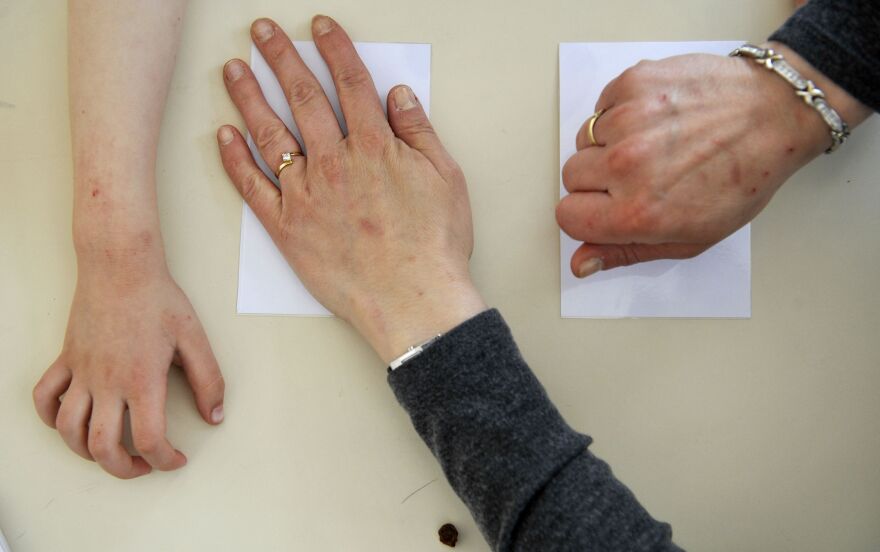How To Know If Applied Behavior Analysis Or Alternative Treatments Are Best For Your Child With Autism

Applied Behavior Analysis (ABA) is a type of therapy that can be used to treat a variety of different behaviors, but its most common application is as a form of therapy for people with autism.
ABA research dates back to the 1950s, with its official certification starting in 1998. Today, ABA is the only method of intervention for autism that is approved for coverage by insurance providers and Medicaid in every state. But as many experts on autism and ABA therapy will tell you, a singular therapy can't be a one-size-fits-all proposition, even though ABA is seen by many practitioners as a flexible approach.
Finding out the best approach for your child or loved one on the autism spectrum can be overwhelming and leave parents and caregivers unsure of how to best assist.
There are a wide range of perspectives on ABA therapy and its utility as therapy for people with autism, so LAist talked with experts with a range of perspectives on the utility of ABA and what alternatives exist out there if you feel ABA isn't the right approach.
An increase in cases and a growing understanding of autism
"When I was in graduate school, autism occurred in 1 in 2,500 individuals... today it's 1 in 36," said Dr. Jan Blacher, research professor of education and psychology at UC Riverside.
-
At magnitude 7.2, buildings collapsed
-
Now spinning in front of Santa Monica apartments
-
Advocates seek end to new LAUSD location policy
The explanation for the rising cases, she said, came from the medical community's changing understanding of what autism is.
Originally, the Diagnostic and Statistical Manual of Mental Disorders (DSM) defined autism as someone who exhibits restrictive, repetitive behavior and deficits in social interactions.
Though this was an established notion for decades, a growing concern became prevalent as more varying cases of autism were diagnosed over the years.
"Instead of just thinking of autism as individuals with an intellectual impairment, no adaptive skills, no language, no communication... we had a lot of children that were very bright, IQs way above range, they spoke and they had some adaptive skills," Blacher said. "And yet, the same intervention procedures were used with all of them."
What to know about the critiques
The idea that ABA can be traumatic for patients goes back to Ole Ivar Lovaas, a clinical psychologist and pioneer in ABA research who incorporated slaps and electric shocks in his work.
"I will say that Lovaas is often quoted as using punishments and aversives, which are unacceptable," said Dr. Sneha Kohli Mathur, an ABA practitioner and psychology professor at USC. "However, if you look at the history of ABA, it goes way back to B.F. Skinner in the 1950s, [where] the goal [had] always been to help people thrive in their lives, not to assimilate or behave normally or neurotypically."
Mathur said if possible, it's important for the autistic person to be consulted about the kind of therapy and intervention they're receiving, because uncommunicative parents can sometimes ignore or overcorrect behaviors.
"[It's about] figuring out what's important to them to work on, teaching self advocacy skills and emotional regulation and skills related to safety or health, not focusing on compliance as has been the issue in the past. I recognize that a lot of autistic folks have been through traumatic experiences with ABA and I don't want to be dismissive of that," said Mathur.
And that can lead to a lack of trust in child-parent relationships, or make kids feel they aren't "good enough," said Zoe Gross, director of advocacy for the Autistic Self-Advocacy Network (ASAN).
"Doing what's called camouflaging autism, or purposefully masking your autistic traits... is associated with increased likelihood of suicidal ideation, as well as anxiety, depression, and stress," Gross added.
Alternatives and self-advocacy
For those seeking alternative treatments, Gross stressed that therapy assessments should be set on a practitioner-to-practitioner basis.
"There's occupational therapy [or] speech-language therapy that can be used to teach either oral speech or the use of communication devices," Gross said.
ASAN has a guide for those looking to evaluate practitioners and whether their intentions align with a family's specific goals. They also offer guides for self-advocating with insurance providers.
In California, awareness of this conversation surrounding the effectiveness of ABA as an autism intervention led to the proposal of a law to expand available treatments for kids in the state with autism. The legislation, Senate Bill 805, was signed into law last October.
"What we want to see in the end is people with better options, helping them learn self-advocacy, about their disability, and how to navigate the world with it," Gross said.
Listen to the conversation
-
Charlotte Maya's memoir, "Sushi Tuesdays: A Memoir of Love, Loss, and Family Resilience" is an intimate looks at how she continues to navigate her husband's suicide.
-
Fentanyl and other drugs fuel record deaths among people experiencing homelessness in L.A. County. From 2019 to 2021, deaths jumped 70% to more than 2,200 in a single year.
-
Prosecutors say Stephan Gevorkian's patients include people with cancer. He faces five felony counts of practicing medicine without a certification.
-
April Valentine died at Centinela Hospital. Her daughter was born by emergency C-section. She'd gone into the pregnancy with a plan, knowing Black mothers like herself were at higher risk.
-
Before navigating domestic life in the United States, AAPI immigrants often navigated difficult lives in their motherlands, dealing with everything from poverty to war.
-
There are plenty of factors in life that contribute to happiness. But could keeping in touch with your loved ones be the most important?






